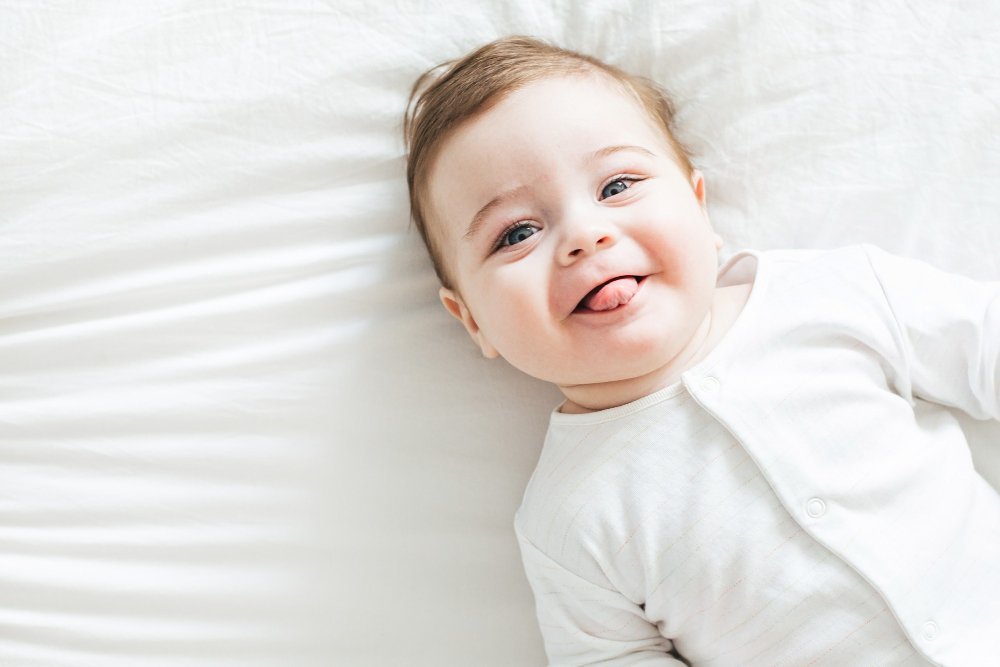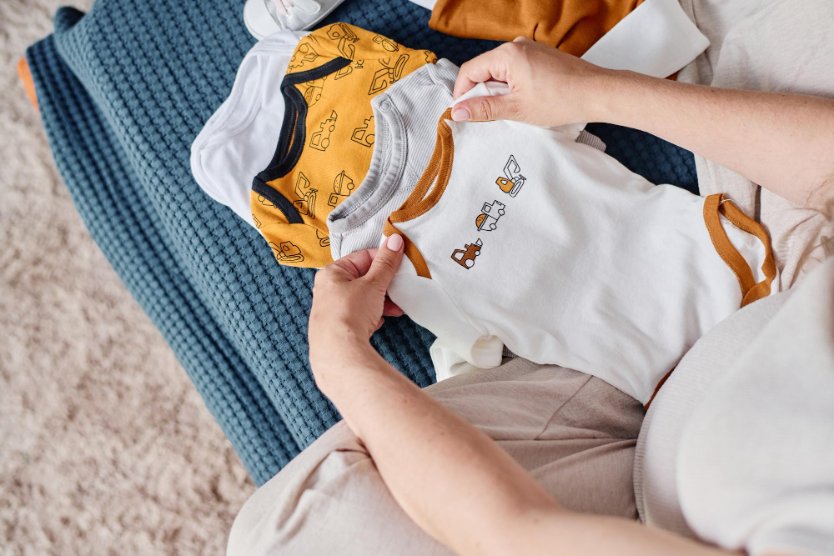Everything parents need to know about choosing safe, comfortable, and chemical-free clothing for babies with sensitive skin
Table of Contents
- Why Hypoallergenic Baby Clothing Matters
- Hidden Chemical Dangers in Baby Clothes
- Understanding Hypoallergenic Clothing
- Safe Fabric Guide for Sensitive Skin
- Microplastics: The Hidden Threat
- What Pediatric Experts Recommend
- Advanced Washing & Care Guide
- Complete Certification Guide
- Special Considerations for Skin Conditions
- Size Transitions & Growth
- Brand Shopping Guide
- Frequently Asked Questions
- Conclusion
Choosing the right clothing for your baby goes far beyond picking cute outfits. When your little one has sensitive skin, finding hypoallergenic options becomes essential for their comfort and health. Hypoallergenic fabrics like organic cotton, bamboo, and Tencel can significantly reduce the risk of skin irritation and allergies in babies, whose delicate skin is much more reactive than adults’.
Recent studies reveal alarming levels of toxic chemicals in baby clothing, with over 8,000 different chemicals used in textile manufacturing. These substances can cause everything from mild skin irritation to serious allergic reactions in babies whose skin barriers are still developing.
The best baby garments combine softness, breathability, and gentle materials. Natural fabrics free from synthetic chemicals not only feel better against your baby’s skin but also help regulate body temperature more effectively. This guide will show you exactly how to protect your baby’s sensitive skin while ensuring they stay comfortable throughout their daily activities.
Hidden Chemical Dangers in Baby Clothes
⚠️ Chemical Alert
Recent Environmental Working Group testing found concerning levels of “forever chemicals” (PFAS) in all 34 baby products tested, including clothing and bedding. These chemicals are linked to immune system suppression and reduced vaccine effectiveness in children.
Understanding what harmful chemicals lurk in baby clothing is the first step to protecting your little one. The textile industry uses over 8,000 chemicals during manufacturing, many of which can remain in finished garments and cause health problems.
Common Toxic Chemicals in Baby Clothing
| Chemical | Found In | Health Risks |
|---|---|---|
| Formaldehyde | Wrinkle-resistant finishes, permanent press fabrics | Skin irritation, respiratory problems, known carcinogen |
| PFAS (Forever Chemicals) | Water-resistant, stain-resistant clothing | Immune system disruption, hormone interference |
| Phthalates | Printed designs, waterproof coatings | Hormone disruption, developmental issues |
| Azo Dyes | Brightly colored fabrics | Allergic reactions, potential carcinogens |
| Heavy Metals | Dyes, printing inks, metal fasteners | Skin irritation, toxicity with prolonged exposure |
| Flame Retardants | Sleepwear, some regular clothing | Hormone disruption, developmental delays |
Why Babies Are More Vulnerable
Babies face higher risks from clothing chemicals because:
- Thinner skin: Baby skin is up to 30% thinner than adult skin, allowing chemicals to absorb more easily
- Developing systems: Their immune, nervous, and endocrine systems are still forming
- Behavioral factors: Babies chew on clothes, blankets, and sleeves, directly ingesting chemicals
- Higher exposure ratio: Their smaller body size means higher chemical exposure per pound of body weight
💡 California’s PFAS Ban
California became the first state to ban PFAS in clothing and textiles starting January 2025. This landmark legislation is likely to influence manufacturing nationwide, making PFAS-free clothing more widely available.
Understanding Hypoallergenic Clothing
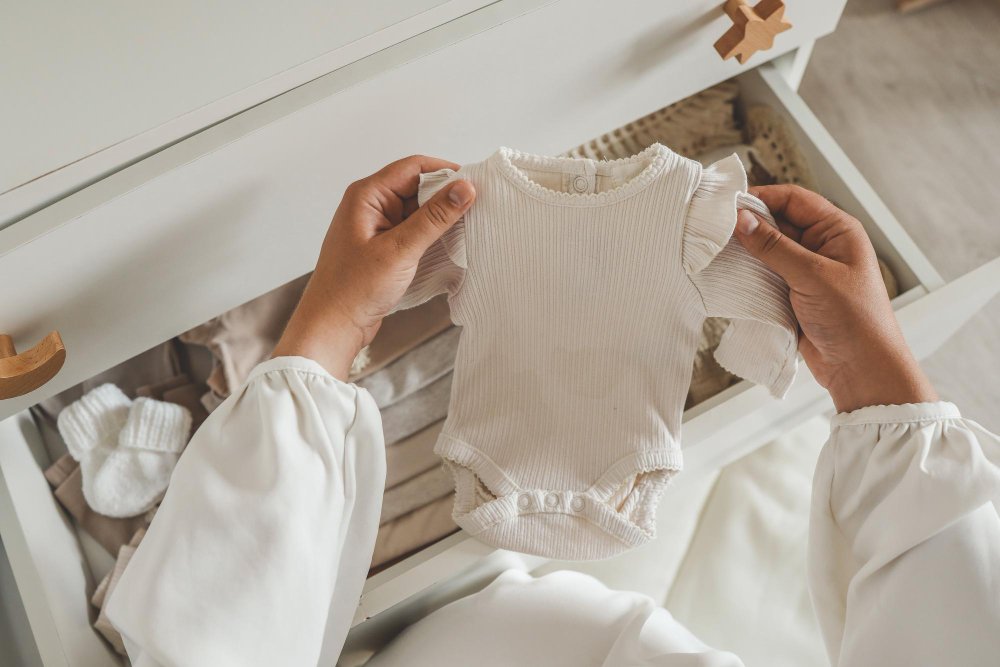
Hypoallergenic clothing offers special protection for babies with delicate skin. These garments are designed specifically to minimize the risk of allergic reactions and skin irritation that common fabrics might cause.
What “Hypoallergenic” Really Means
Hypoallergenic clothing refers to garments made from materials that are less likely to trigger allergic reactions. These fabrics are typically:
- Free from harsh chemicals, dyes, and other potential irritants
- Made from naturally gentle fibers
- Processed without synthetic pesticides or chemical treatments
- Tested for skin safety and allergen content
Organic cotton stands out as a premier hypoallergenic option because it’s grown without pesticides or chemical fertilizers. This makes it gentler on a baby’s skin compared to conventional cotton.
Benefits for Babies with Sensitive Skin
Hypoallergenic clothing provides significant advantages for babies prone to skin problems:
- Reduced irritation: For infants with eczema, these gentle fabrics can reduce flare-ups and discomfort
- Better temperature control: The breathable nature helps regulate body temperature and prevents excessive sweating
- Improved sleep: Babies with sensitive skin often sleep better in hypoallergenic clothing due to reduced irritation
- Preventative protection: For babies with known allergies, these garments help reduce exposure to common irritants
Safe Fabric Guide for Sensitive Skin
The right fabric choice makes a huge difference in your baby’s comfort and skin health. Babies have sensitive skin that needs gentle, breathable materials to prevent irritation and allergic reactions.
Organic Cotton
The gold standard for baby clothing, organic cotton is grown without harmful pesticides and chemicals.
✅ Pros
- GOTS certified options available
- Breathable and moisture-absorbing
- Gets softer with each wash
- Widely available
❌ Considerations
- More expensive than conventional
- May shrink if not pre-shrunk
- Takes longer to dry
Bamboo Fabric
Naturally antimicrobial and incredibly soft, bamboo offers superior breathability and moisture-wicking properties.
✅ Pros
- Natural antibacterial properties
- Absorbs 40% more moisture than cotton
- Silky-soft texture
- Temperature regulating
❌ Considerations
- Processing methods vary in eco-friendliness
- Can be more expensive
- May require special care
TENCEL Lyocell
Made from sustainably sourced wood pulp, TENCEL is produced through an environmentally responsible closed-loop process.
✅ Pros
- Naturally hypoallergenic
- Excellent moisture management
- Silk-like softness
- Eco-friendly production
❌ Considerations
- Higher cost
- Limited availability
- May wrinkle easily
Merino Wool
Superfine merino wool is naturally temperature-regulating, breathable, and antibacterial when specially processed.
✅ Pros
- Natural temperature regulation
- Odor-resistant
- Moisture-wicking
- Naturally hypoallergenic
❌ Considerations
- Requires special care
- Can be expensive
- Some babies may be sensitive to wool
What is the Best Fabric for Sweaty Babies?
For babies who tend to overheat or sweat easily, bamboo fabric is the top choice. Its superior moisture-wicking properties pull sweat away from the skin, while its breathable structure allows excellent air circulation. TENCEL lyocell is another excellent option, offering comparable moisture management with a silky-smooth feel that won’t irritate sensitive skin.
What Material is Best for Babies in Summer?
During hot weather, lightweight organic cotton and bamboo blends work best. These materials provide maximum breathability while maintaining softness. Look for loose-weave fabrics that allow air to flow freely. Avoid synthetic materials like polyester, which can trap heat and cause overheating.
What is the Best Fabric for Sensory Issues?
For babies with sensory processing sensitivities, ultra-soft bamboo and modal fabrics offer the gentlest touch. These materials have no rough fibers and provide a smooth, consistent texture. TENCEL lyocell is particularly beneficial due to its silk-like feel and complete absence of irritating elements. Always choose tagless options and flat seams to minimize sensory triggers.
Fabrics to Avoid
❌ Avoid These Materials
- Polyester: Traps heat and moisture, can cause rashes
- Conventional cotton: May contain pesticide residues
- Acrylic: Synthetic plastic-based fabric that sheds microfibers
- Treated fabrics: Water-resistant, stain-resistant, or wrinkle-free treatments often contain harmful chemicals
- Rough wool: Can irritate sensitive skin
Microplastics: The Hidden Threat
One of the most overlooked dangers in baby clothing is microplastic pollution. When synthetic fabrics are washed, they release millions of tiny plastic fibers that can be inhaled or ingested by babies, who are particularly vulnerable to microplastic exposure.
🚨 Alarming Statistics
- Babies ingest up to 22 times more microplastics than adults
- A single wash load can release 1.5 million synthetic microfibers
- Microplastics have been found in 75% of human breast milk samples
- Bottle-fed babies consume over 1.6 million microplastics daily
How Babies Are Exposed to Microplastics
Babies face microplastic exposure through several pathways:
- Clothing contact: Synthetic fabrics shed fibers during wear
- Washing process: Microfibers released during laundry settle as household dust
- Oral exploration: Babies naturally mouth clothing, blankets, and toys
- Indoor air: Synthetic textiles release airborne microfibers
Health Concerns
While research is ongoing, microplastics have been linked to:
- Hormone disruption
- Immune system interference
- Potential cancer risks
- Developmental delays
- Respiratory irritation
Reducing Microplastic Exposure
✅ Action Steps to Minimize Microplastics
- Choose natural fiber clothing over synthetic materials
- Use microfiber-catching laundry bags for any synthetic items
- Install washing machine microfiber filters
- Wash synthetic clothes less frequently and in full loads
- Use natural fiber rugs and carpets in nurseries
- Choose organic cotton stuffed animals over polyester
- Vacuum and dust regularly to remove settled microfibers
- Open windows daily for fresh air circulation
What Pediatric Experts Recommend
“A lot of the specific ‘baby’ labels on detergents are simple marketing tools, but they’re still usually a reliable indicator that a detergent is safe for baby’s delicate skin. Look for one that is fragrance-free, dye-free, uses plant-based ingredients and has a hypoallergenic claim.”
Medical Professional Guidelines
Pediatric dermatologists consistently recommend these principles for baby clothing:
- Natural fibers first: Cotton, linen, silk, and hemp are preferred over synthetics
- Loose-fitting garments: Prevent heat buildup and reduce friction against sensitive skin
- Fragrance-free everything: From detergents to fabric softeners
- Double-rinse protocol: Extra rinse cycles remove detergent residue
- Pre-wash new clothes: Remove manufacturing chemicals before first wear
Dermatologist-Approved Clothing Features
| Feature | Why It Matters | What to Look For |
|---|---|---|
| Flat Seams | Reduces friction and irritation | Overlocked or bound seams, no raised edges |
| Tagless Design | Eliminates scratchy labels | Printed care information, no sewn-in tags |
| Open Necklines | Prevents heat buildup | Avoid turtlenecks and tight collars |
| Natural Dyes | Minimizes chemical exposure | Plant-based or low-impact dyes |
When to Consult a Specialist
Contact a pediatric dermatologist if your baby shows:
- Persistent rashes despite using hypoallergenic clothing
- Severe skin reactions to specific fabrics
- Eczema that doesn’t improve with gentle clothing choices
- Signs of allergic reactions like hives or swelling
Advanced Washing & Care Guide
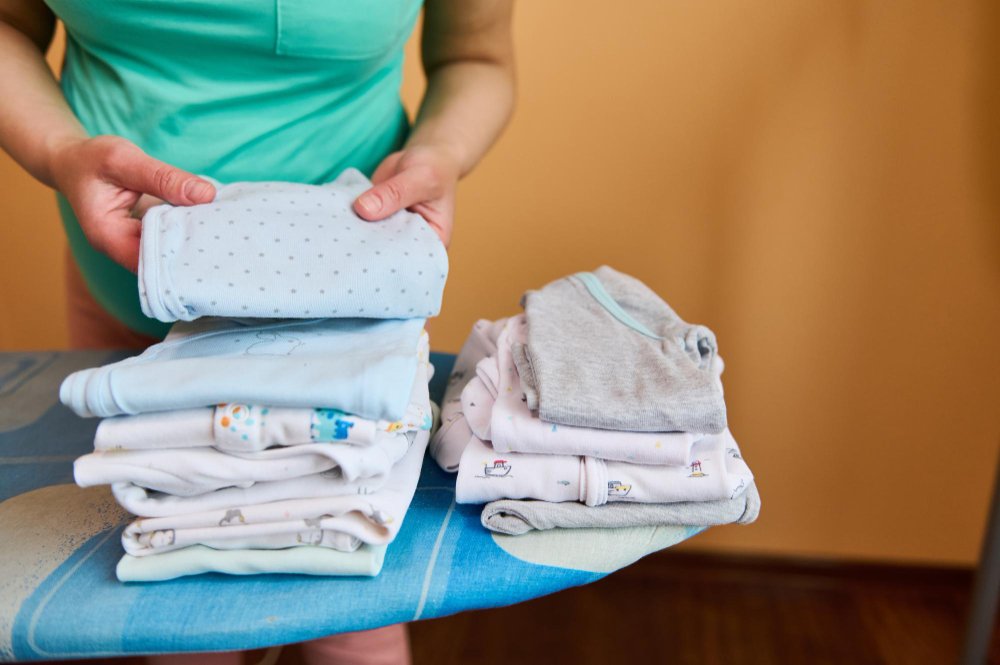
Proper care of hypoallergenic baby clothes is just as important as choosing the right fabrics. The way you wash and maintain these garments directly impacts their safety and effectiveness for sensitive skin.
Can You Use Hypoallergenic Detergent for Baby Clothes?
Absolutely, and it’s highly recommended by pediatric dermatologists. Hypoallergenic detergents are specifically formulated to minimize skin irritation and allergic reactions. Look for detergents that are:
- Fragrance-free and dye-free
- Plant-based with minimal ingredients
- pH-neutral to prevent skin irritation
- Certified by the National Eczema Association
- Free from sulfates, phosphates, and optical brighteners
Dermatologist-Recommended Detergents
| Brand | Key Features | Best For |
|---|---|---|
| All Free Clear | Pediatrician recommended, completely fragrance-free | Babies with eczema and severe sensitivities |
| Seventh Generation Free & Clear | Plant-based, EPA Safer Choice certified | Environmentally conscious families |
| Babyganics 3X | National Eczema Association certified, triple concentrated | Heavy-duty cleaning with gentleness |
| Tide Free & Gentle | Recognized by National Eczema Association | Mainstream option with proven effectiveness |
Step-by-Step Washing Protocol
✅ Optimal Washing Routine for Sensitive Skin
- Pre-wash new clothes: Always wash before first wear to remove manufacturing chemicals
- Separate baby laundry: Avoid contamination from adult clothing treatments
- Use appropriate water temperature: Warm water (86-104°F) for cleaning, cool for rinsing
- Double-rinse: Select extra rinse cycle to remove all detergent residue
- Avoid fabric softeners: These coat fibers with chemicals and reduce flame retardancy
- Use wool dryer balls: Natural alternative to dryer sheets for softness
- Air dry when possible: Reduces heat damage and chemical exposure
Microplastic Reduction Techniques
To minimize microplastic release during washing:
- Wash full loads: Reduces friction between garments
- Use cold water: Hot water increases microfiber shedding
- Avoid delicate cycles: Extra water increases microfiber release
- Install microfiber filters: Capture plastic particles before they enter waterways
- Use Guppyfriend bags: Special washing bags that catch microfibers
💡 Pro Tip: The 3-Minute Rule
Apply moisturizer to your baby’s skin within three minutes of removing them from the bath. This locks in moisture and creates a protective barrier against any residual irritants from clothing.
Complete Certification Guide
Understanding certification labels helps you identify truly safe and hypoallergenic baby clothing. Not all certifications are created equal, so knowing what each one guarantees is crucial.
Major Certification Standards
| Certification | What It Guarantees | Strictness Level |
|---|---|---|
| GOTS (Global Organic Textile Standard) | Organic fiber content, environmental criteria, social criteria throughout supply chain | Very High |
| OEKO-TEX Standard 100 | Tested for harmful substances, including accessories and components | High |
| OEKO-TEX ECO PASSPORT | Chemical components meet human-ecological requirements | Medium-High |
| Cradle to Cradle Certified | Material health, renewable energy use, water stewardship | High |
| GREENGUARD Gold | Low chemical emissions, suitable for children and schools | Medium |
How to Verify Authentic Certifications
- Check certification numbers: Legitimate certifications include unique tracking numbers
- Visit official websites: Verify companies through certification body databases
- Look for complete labeling: Authentic certificates show specific test results
- Be wary of vague claims: Terms like “natural” or “eco-friendly” without certification mean little
- Compare brands systematically: Use our baby clothing brands comparison guide to evaluate certification levels across different manufacturers
⚠️ Greenwashing Alert
Beware of misleading marketing terms like “hypoallergenic,” “natural,” or “organic” without proper certification. These terms are often unregulated and can be used by any manufacturer without verification.
Special Considerations for Skin Conditions
Some babies have unique skin concerns that require extra attention when choosing clothes. Selecting the right fabrics and features can make a significant difference in managing skin conditions and maintaining comfort.
Choosing Clothes for Babies with Eczema
Babies with eczema need extra-gentle clothing options. Medical experts recommend:
- 100% organic cotton: Choose garments with flat seams to minimize irritation
- Tagless options: Tags can scratch sensitive skin during flare-ups
- Loose-fitting clothes: Prevent rubbing against irritated areas
- Light colors: Dark dyes may contain more irritating chemicals
- Seamless designs: Minimize friction points that can worsen eczema
“For babies with eczema, the easiest way to prevent clothes-based flare-ups is to dress your baby in natural fabrics only. These include cotton, linen, silk, and hemp. Whatever natural fabric you choose, it should be smooth, pliable, and pleasant to the touch.”
Temperature Regulation for Sensitive Skin
Proper temperature regulation is crucial for babies with sensitive skin, as overheating can trigger rashes and worsen existing skin conditions.
- Layer strategically: Use multiple thin layers rather than one thick garment
- Choose breathable fabrics: Bamboo and organic cotton adjust to body temperature
- Monitor for overheating signs: Flushed cheeks, sweaty neck, or restlessness
- Adjust for sleep: Dress babies in one more layer than you find comfortable
Managing Allergic Reactions
If your baby shows signs of fabric allergies:
🚨 When to Seek Medical Help
- Persistent rashes that don’t improve with gentle fabrics
- Hives or swelling after wearing certain materials
- Breathing difficulties or other severe reactions
- Eczema that worsens despite using hypoallergenic clothing
Size Transitions & Growth
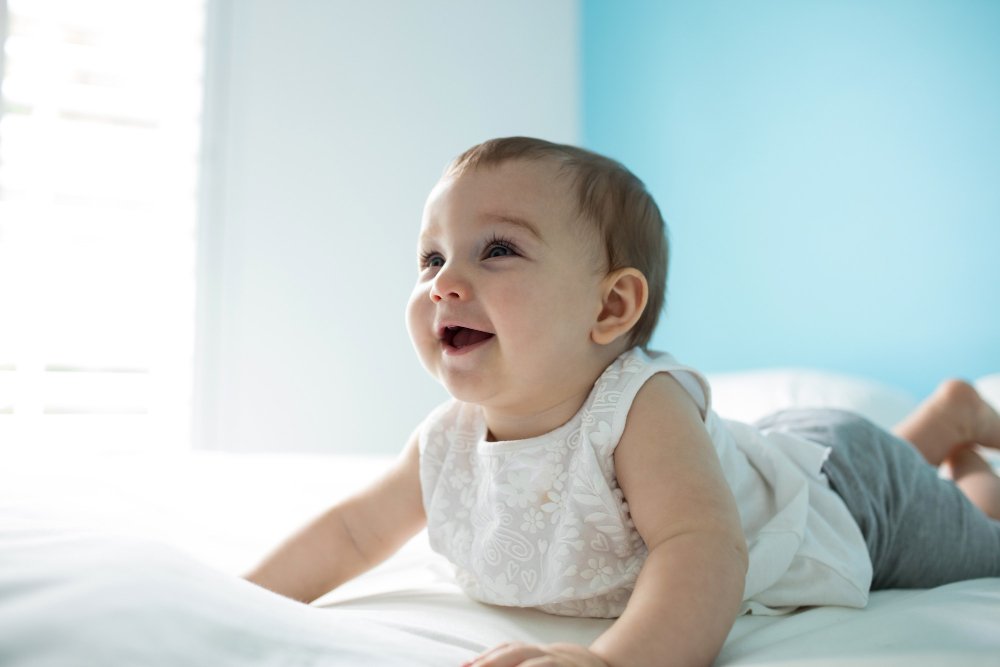
As babies grow rapidly, proper sizing becomes crucial for both comfort and skin protection. Understanding when and how to transition sizes helps maintain the benefits of hypoallergenic clothing.
When to Size Up for Sensitive Skin
For babies with sensitive skin, sizing up sooner rather than later is often beneficial:
- Before tightness occurs: Tight clothing can rub and irritate sensitive areas
- Allow for air circulation: Loose-fitting clothes prevent heat buildup
- Accommodate movement: Growing babies need room to move without fabric stress
- Consider seasonal changes: Size up before weather transitions
Growth Spurt Considerations
During rapid growth periods, pay attention to:
- Sleeve and leg length: Short sleeves can bind and cause irritation
- Waistband pressure: Tight waistbands can cause red marks and discomfort
- Neck openings: Ensure easy dressing without stretching fabric over baby’s head
Seasonal Transition Tips
When transitioning between seasons while maintaining skin safety:
- Gradual changes: Introduce new fabrics slowly to test for reactions
- Layer compatible materials: Ensure all layers are hypoallergenic
- Consider indoor/outdoor temperatures: Plan for varying conditions throughout the day
Brand Shopping Guide
Choosing the right brands can simplify your search for safe, hypoallergenic baby clothing. Here are trusted options across different price ranges and availability.
Premium Hypoallergenic Brands
Colored Organics
100% GOTS certified organic cotton, made in India with fair trade practices.
- Price range: $15-45 per item
- Specialty: Vibrant colors with organic dyes
- Available: Online direct and select retailers
Pehr
Regenerative organic cotton with heirloom quality construction.
- Price range: $25-80 per item
- Specialty: Durable, sophisticated designs
- Available: Online and boutique stores
Angel Dear
Bamboo viscose blends with exceptional softness standards.
- Price range: $12-35 per item
- Specialty: Ultra-soft bamboo fabrics
- Available: Wide retail distribution
Budget-Friendly Options
Affordable hypoallergenic choices that don’t compromise on safety:
- Target’s Cat & Jack Organic Line: GOTS certified organic cotton at mainstream prices
- H&M Conscious Collection: Organic cotton basics with transparent sourcing
- Primary: Simple, chemical-free cotton in solid colors
For budget-conscious parents, consider shopping for quality baby clothes from trusted retailers that offer organic and hypoallergenic options at discounted prices.
To help you make informed decisions, check out our comprehensive safe baby clothing brands comparison tool that evaluates different brands based on safety certifications, fabric quality, and hypoallergenic properties.
Red Flags to Avoid
❌ Warning Signs in Baby Clothing
- Strong chemical odors when opening packages
- Clothing labeled “wrinkle-free” or “stain-resistant”
- Excessive use of synthetic materials
- Lack of care instruction details
- No information about fabric source or processing
- Rough textures or scratchy seams
Where to Shop
- Online specialty retailers: Largest selection of certified organic options
- Local boutiques: Often carry curated hypoallergenic brands
- Mainstream stores: Increasingly offering organic lines
- Second-hand options: Pre-washed clothes have fewer chemical residues
Frequently Asked Questions
Pediatric dermatologists recommend natural, breathable fabrics for babies with eczema. Organic cotton is excellent because it’s soft, chemical-free, and allows skin to breathe. Bamboo fabric is another great choice due to its hypoallergenic properties and smooth texture with no sharp fibers. TENCEL lyocell works well for eczema-prone babies because it’s extremely soft and moisture-wicking, preventing sweat-related irritation.
Yes, loose-fitting pajamas made from 100% organic cotton offer the best comfort for babies with eczema. They allow air circulation and minimize friction against irritated skin. Look for seamless pajamas or those with flat seams, and choose tagless designs to reduce irritation points. Pajamas with attached mittens can prevent nighttime scratching, which often worsens eczema symptoms.
TENCEL has superior moisture management properties that keep baby’s skin dry, reducing the growth of irritation-causing bacteria. It’s naturally antimicrobial and requires fewer chemical treatments during production, meaning fewer potential allergens. TENCEL has an exceptionally smooth surface that won’t aggravate sensitive skin, and its temperature-regulating properties help prevent overheating, which can trigger flare-ups.
The fabric composition is most important – prioritize natural, breathable materials like organic cotton and bamboo over synthetics. Look for certifications like GOTS (Global Organic Textile Standard) that ensure the fabric is free from harmful chemicals. Consider garment construction too – avoid excessive decorations, appliqués, and rough seams that can irritate sensitive skin. Our safe baby clothing brands tool can help you identify which brands meet these essential criteria.
While natural fabrics are generally preferred, some high-quality synthetic fabrics can be suitable if they’re properly certified. Look for OEKO-TEX certified synthetics that have been tested for harmful substances. However, be aware that synthetic fabrics shed microplastics during washing, which can be concerning for babies who explore the world through their mouths. When possible, choose natural alternatives.
Wash baby clothes before first wear and after each use to remove any irritants. Use a hypoallergenic, fragrance-free detergent and always do a double rinse to remove all soap residue. Wash baby clothes separately from adult laundry to avoid contamination from harsh detergents or fabric softeners. Air drying is preferable to reduce chemical exposure from dryer sheets.
Conclusion
Protecting your baby’s sensitive skin through careful clothing choices is one of the most important steps you can take as a parent. The clothing your baby wears directly impacts their comfort, health, and overall well-being during these crucial developmental months.
Essential Action Steps
✅ Your Complete Baby Clothing Safety Checklist
- Choose certified organic fabrics: Look for GOTS certified organic cotton, bamboo, or TENCEL as your first choices
- Avoid toxic chemicals: Stay away from wrinkle-resistant, stain-resistant, or water-repellent treatments that contain PFAS
- Read certification labels carefully: Verify authentic certifications through official databases
- Use hypoallergenic detergents: Choose fragrance-free, dye-free options recommended by pediatric dermatologists
- Implement double-rinse washing: Ensure all detergent residue is removed from baby clothes
- Minimize microplastic exposure: Choose natural fibers and use microfiber-catching washing solutions
- Size appropriately: Ensure loose-fitting clothes that allow air circulation and movement
- Monitor for reactions: Watch for signs of skin irritation and adjust fabric choices accordingly
Top Fabric Recommendations
Based on medical expert advice and extensive research, here are the best fabric choices for babies with sensitive skin:
For detailed brand-specific recommendations and safety ratings, explore our comprehensive baby clothing brands comparison that evaluates each option based on these exact criteria.
- GOTS Certified Organic Cotton: The gold standard for safety, breathability, and comfort
- Bamboo Viscose: Exceptional for moisture-wicking and natural antibacterial properties
- TENCEL Lyocell: Premium option for ultimate softness and eco-friendly production
- Superfine Merino Wool: Excellent for temperature regulation when specially processed for baby use
Long-term Benefits
Investing in quality hypoallergenic clothing for your baby provides benefits that extend far beyond immediate comfort:
- Healthier skin development: Reduced exposure to irritants allows your baby’s skin barrier to develop properly
- Better sleep quality: Comfortable, breathable fabrics contribute to more restful sleep
- Reduced medical costs: Fewer skin problems mean fewer doctor visits and prescription treatments
- Environmental protection: Choosing organic and sustainable options helps create a healthier planet for your child’s future
- Peace of mind: Knowing you’ve chosen the safest options allows you to focus on other aspects of parenting
Looking Ahead: 2025 and Beyond
The baby clothing industry is rapidly evolving toward safer, more sustainable options. Key trends to watch include:
- Stricter regulations: More states following California’s lead in banning harmful chemicals
- Improved certifications: Enhanced testing standards for chemical safety
- Innovative materials: New eco-friendly fibers with improved hypoallergenic properties
- Greater transparency: Brands providing more detailed information about their manufacturing processes
Final Recommendations
Remember that every baby is unique, and what works for one may not work for another. Start with the safest options – certified organic cotton and bamboo – and observe how your baby’s skin responds. Don’t hesitate to consult with your pediatrician or a pediatric dermatologist if you notice persistent skin issues.
The investment in hypoallergenic baby clothing pays dividends in your child’s comfort, health, and development. By following the guidelines in this comprehensive guide, you’re giving your baby the best possible start with clothing that protects their delicate skin while supporting healthy growth and development.
For more information about safe baby clothing choices and other infant clothing essentials, continue exploring our expert guides and resources.

